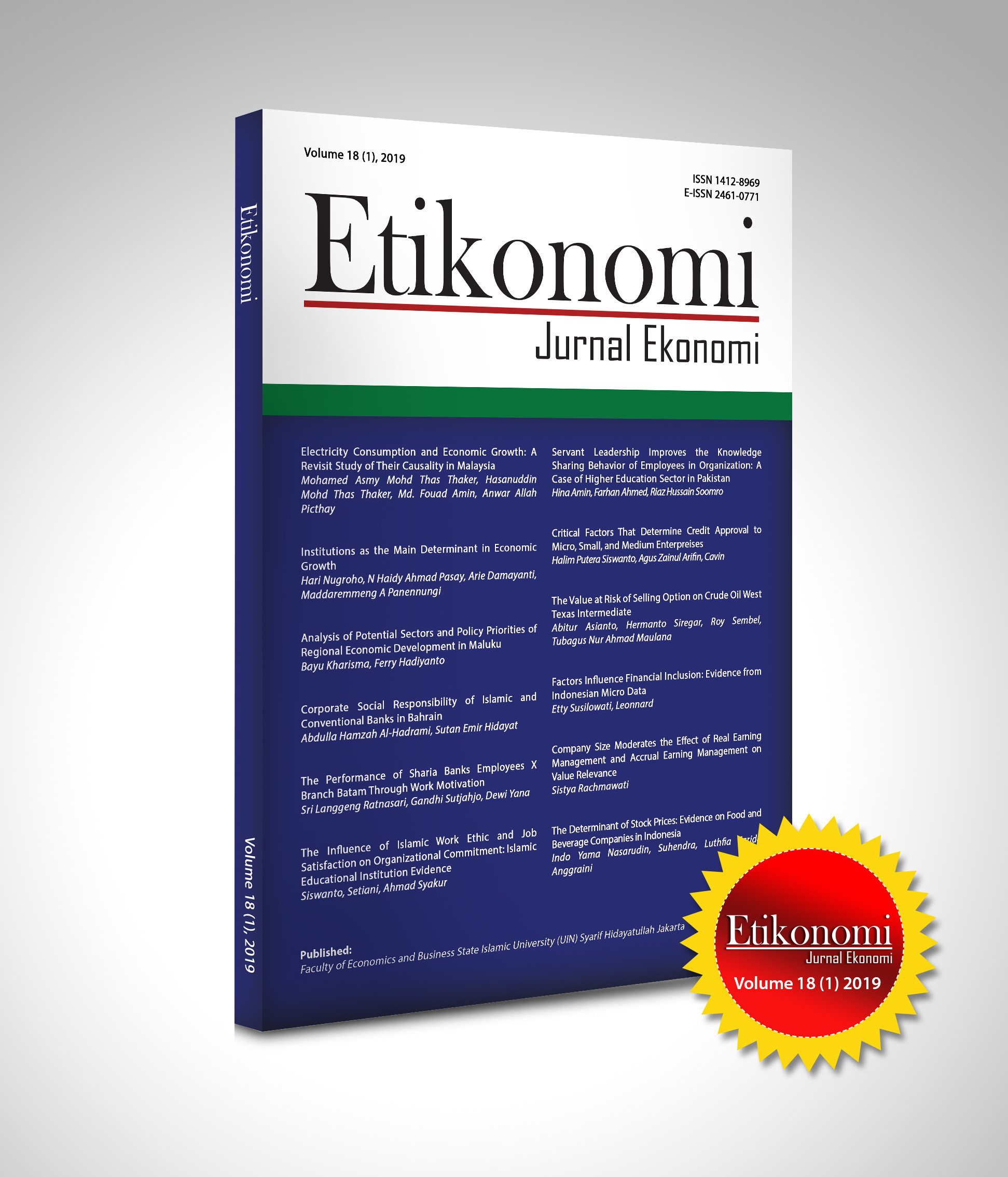Factors Influence Financial Inclusion: Evidence from Indonesian Micro Data
DOI:
https://doi.org/10.15408/etk.v18i1.9070Keywords:
financial inclusion, individual characteristics, saving, loanAbstract
In order to increase access to formal financial institutions, the Indonesian government has issued various national strategies. However, Indonesia’s inclusive financial index is still under other ASEAN countries. Therefore, in this study, we investigate the factors that influence financial inclusion in Indonesia. The microdata from global findex 2014 was carried out in this study by using binary logistic regression analysis. The finding indicates that there is a significant positive relationship between individual characteristics, including financial inclusion, constraints to financial inclusion, utilization of financial services motivation, and loan sources. Since the main targets of financial inclusion are the poor, this finding becomes an essential proposition for policies in the banking sector, that besides the factors of gender, age, education, and type of jobs, income is the primary factor that influences access and utilization of financial services. Mainly regarding loans, increased income will increase the opportunities of the poor to getting loans because only high-income groups have collateral in applying for loans.
JEL Classification: D14, G20
Downloads
References
Allen, F., Demirguc-Kunt, A., Klapper, L., & Martinez Peria, M. S. (2016). The Foundations of Financial Inclusion: Understanding Ownership and Use of Formal Accounts. Journal of Financial Intermediation, 27(2016), 1–30. https://doi.org/10.1016/j.jfi.2015.12.003.
Anzoategui, D., Demirgüç-Kunt, A., & Martínez Pería, M. S. (2014). Remittances and Financial Inclusion: Evidence from El Salvador. World Development, 54, 338–349. https://doi.
org/10.1016/j.worlddev.2013.10.006.
Arun, T., & Kamath, R. (2015). Financial inclusion: Policies and practices. IIMB Management Review, 27(4), 267–287. https://doi.org/10.1016/j.iimb.2015.09.004.
Aterido, R., Beck, T., & Iacovone, L. (2013). Access to Finance in Sub-Saharan Africa: Is There a Gender Gap? World Development, 47, 102–120. https://doi.org/10.1016/j.
worlddev.2013.02.013.
Bank Indonesia. (2014). Booklet Keuangan Inklusif. Departemen Pengembangan Akses Keuangan dan UMKM. Retrieved July 27, 2017, from http://www.bi.go.id/id/
perbankan/keuanganinklusif/edukasi/Contents/Buku Saku Keuangan Inklusif.pdf.
Becker, G. S. (1975). Human capital. New York: Columbia University Press.
Chakravarty, S. R., & Pal, R. (2013). Financial Inclusion in India: An Axiomatic Approach. Journal of Policy Modeling, 35(5), 813–837. https://doi.org/10.1016/j.jpolmod.2012.12.007.
Chauvet, L., & Jacolin, L. (2017). Financial Inclusion, Bank Concentration, and Firm Performance. World Development, 97, 1–13. https://doi.org/10.1016/j.worlddev.2017.03.018.
Claessens, S. (2006). Access to Financial Services: A Review of the Issues and Public Policy Objectives. World Bank Research Observer, 21(2), 207–240. https://doi.org/10.1093/wbro/lkl004.
Collins, D., Morduch, J., Rutherford, S., Ruthven, O. (2009). Portfolios of the Poor: How The World’s Poor Live on $2 a Day. Princeton, NJ.: Princeton University Press.
Conroy, J. (2005). APEC and Financial Exclusion: Missed Opportunities for Collective Action? Asia Pacific Development Journal, 12(1), 53–80. https://doi.org/10.1017/CBO9781107415324.004.
Demombynes, G., & Thegeya, A. (2012). Kenya’s Mobile Revolution and the Promise of Mobile Savings. World Bank Policy Research Working Paper No. 12/5988, 5988(1), 32.
https://doi.org/doi:10.1596/1813-9450-5988.
Fungáčová, Z., & Weill, L. (2014). Understanding Financial Inclusion in China. China Economic Review, 34, 196–206. https://doi.org/10.1016/j.chieco.2014.12.004.
Galor, O., & Zeira, J. (1993). Income Distribution Macroeconomics. Review of Economic Studies, 60(1), 35-52. https://doi.org/10.2307/2297811.
Ghosh, S., & Vinod, D. (2017). What Constrains Financial Inclusion for Women? Evidence from Indian Micro data. World Development, 92, 60–81. https://doi.org/10.1016/j.
worlddev.2016.11.011.
Global Partnership for Financial Inclusion. (2011). G20 principles for innovative financial inclusion. Alliance for Financial Inclusion Bangkok Thailand. Retrieved July 27, 2017, from https://www.gpfi.org/sites/default/files/documents/G20 Principles for Innovative Financial Inclusion - AFI brochure.pdf
Han, R., Melecky, M., & Bank, W. (2013). MPRA Paper No. 48338, posted 19, (48338), 58. Retrieved from http://mpra.ub.uni-muenchen.de/48338/
Hosmer Jr, D. W., & Lemeshow, S. (2000). Applied Logistic Regression (2nded). New York: John Wiley & Sons.
Kim, D. W., Yu, J. S., & Hassan, M. K. (2018). Financial Inclusion and Economic Growth in OIC Countries. Research in International Business and Finance, 43, 1–14. https://doi.
org/10.1016/j.ribaf.2017.07.178
Kostov, P., Arun, T., & Annim, S. (2015). Access to Financial Services: The Case of the “Mzansi” Account in South Africa. Review of Development Finance, 5(1), 34–42. https://
doi.org/10.1016/j.rdf.2015.04.001
Menon, N., & van der Meulen, Y. (2011). How Access to Credit Affects Self Employment: Differences by Gender During India’s Rural Banking Reform. Journal of Development
Studies, 47(1), 48–69. https://doi.org/10.1080/00220381003706486
Ouma, S. A., Odongo, T. M., & Were, M. (2017). Mobile Financial Services and Financial Inclusion: Is it a Boon for Savings Mobilization? Review of Development Finance, 7(1),
–35. https://doi.org/10.1016/j.rdf.2017.01.001
Ramos, J. G. R., Teles Correa, M. D., de Carvalho, R. T., Jones, D., & Forte, D. N. (2017).
Clinical Significance of Palliative Care Assessment in Patients Referred for Urgent Intensive Care Unit Admission: A Cohort Study. Journal of Critical Care, 37, 24–29. https://doi.org/10.1016/j.jcrc.2016.08.018
Santoso, A. B., Trinugroho, I., Nugroho, L. I., Saputro, N., & Purnama, M. Y. I. (2016).
Determinants of Financial Literacy and Financial Inclusion Disparity within a Region:Evidence from Indonesia. Advanced Science Letters, 22(5–6), 1622–1624.
Shem, A. O., Misati, R., & Njoroge, L. (2012). Factors Driving Usage of Financial Services From Different Financial Access Strands in Kenya. Savings and Development, 36(1), 71–
https://doi.org/10.2307/savideve.36.1.71
Sun Y. (2015). Financial Inclusion: Study from Indonesia. Advanced Science Letters, 21(4), 1039–1043.
Swamy, V. (2014). Financial Inclusion, Gender Dimension, and Economic Impact on Poor Households. World Development, 56, 1–15. https://doi.org/10.1016/j.worlddev.2013.10.019
Trinugroho, I., Agusman, A., Ariefianto, M. D., Darsono, D., & Tarazi, A. (2015). Determinants of Cross Regional Disparity in Financial Deepening: Evidence From Indonesian Provinces.
Economics Bulletin, 35(2), 896–910.
Wardhono, A., Qori’Ah, C. G., & Indrawati, Y. (2016). The Determinants of Financial Inclusion:Evidence from Indonesian Districts. International Journal of Economic Perspectives, 10(4), 472–483.
World Bank. (2014). Global Financial Development Report 2014: Financial Inclusion.Washington, DC: World Bank.
Zins, A., & Weill, L. (2016). The Determinants of Financial Inclusion in Africa. Review of Development Finance, 6(1), 46–57. https://doi.org/10.1016/j.rdf.2016.05.001










